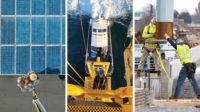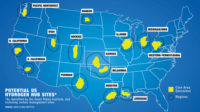Using one of the largest marine cranes on the East Coast, contractor teams on Jan. 18 carefully but quickly orchestrated the lift of a US Airways airplane from New York City’s icy Hudson River. The damaged Airbus A320, whose pilot miraculously and safely brought the plane down on the waterway three days before, weighed 100 tons and had filled with another 350 tons of water. Its 155 passengers and crew survived the landing.

The retrieval operation was masterminded by Weeks Marine Inc., Cranford, N.J., one of the country’s largest marine and dredging contractors, and its project partner J. Supor & Sons Inc., a Harrison, N.J.-based trucking and rigging firm. Weeks Marine President Richard S. Weeks says Supor already has an ongoing emergency contract with the National Trans-portation Safety Board and AIG, US Airways’ insurer.
The team’s plan to lift the plane intact won it the job over contractors that proposed to disassemble it first, says Jason L. Marchioni, 35, manager of Weeks Marine’ heavy-lift division and a 15-year company veteran. “No one has ever recovered a jet lost in water. We didn’t know how structurally sound it would be,” he says.
The craft, which may have suffered two bird strikes and lost power soon after liftoff from LaGuardia Airport, is being carefully studied by NTSB and other investigators. One engine is still missing in the river, and the other hung precariously from the fusilage.
To lift the damaged craft, the team deployed a Clyde model 52 crane, a 500-ton crane that Weeks says is the largest revolving crane in use on the East Coast. Originally built in the 1970s as a steam crane, it was electrified in the late 1990s as part of a total overhaul. “We resurrected it from the dead,” he says. The machine, mounted on a 300-ft x 90-ft barge, requires significantly less room to rotate 360° and is moored without cables which could have interfered with other river traffic, says Marchioni. The machine also can maintain a 3° list, he adds.
The plane had been towed downstream from where it was put down and moored near Ground Zero in lower Manhattan. It was in 40 ft of water, often surrounded by ice floes, depending on river tides. One key challenge was dislodging its right wing, which had gotten caught in the pier structure and in river sediment. Marchioni says city officials were concerned about the pier’s stability, but Supor and Weeks engineers jointly designed a rigging plan using a mechanical winch that rotated and dislodged the aircraft and allowed it be lifted in one piece. The project also made use of a 115-ton Dravo model 37 marine crane.
Weeks’ divers David Streubel, Art McManus, Jason Monarch, Al Defario and David Hoy also had to contend with visibility of less than 1.5 ft, river current of 1.5 knots and 40° water temperature. “Work was done by feel,” says Marchioni. He says diving suits had specially cut holes into which warm water was piped by hose. The retrieval, begun on Jan. 16, was completed at 5:30 a.m. on Jan. 18 after a marathon 22-hour effort. Marchioni says other proposals had called for a retrieval that would have taken at least a week. He says Weeks has performed over 2,000 heavy lifts without accident.
The damaged plane was loaded onto a 250-ft-long by 75-ft-wide barge and transported to Weeks’ marine yard in Jersey City, N.J., where its wings will be removed and tail section cut down for eventual movement by Supor to another location for further study by investigators. Officials declined to disclose that location or the planned transfer date. They also did not disclose the lift’s contract value, which is being performed on a time and materials basis.
Officials note support from city police, fire and emergency officials as well as the Red Cross. “One dividend of terrorism is that the level of cooperation is huge,” says Weeks. “Everyone knows what they’re supposed to do.”











































